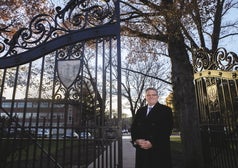Certificate Programs Help Area Schools Meet Market Demands
Like many college students today, Natalie Ballard, a junior psychology major at Becker College in Worcester, believed gaining a specific, marketable skill was important.
To get hands-on, real-world experience, her department chair advised her to enroll in a certificate program while she pursued her bachelor's degree. Through Becker's new Applied Behavior Analysis certificate program, she works at a school for children with special needs while accumulating more than 1,000 hours of work under the supervision of a board-certified applied behavior analyst. The work qualifies Ballard to sit for the board exam.
“You can say when you apply for jobs, 'I have this much experience,” Ballard said. “You have something for your resume.”
To keep up with market demands and additional skills, colleges and universities are creating new certificate programs. According to a recent Georgetown University study, the number of certificate recipients has increased from about 2 percent of all students in 1984 to 12 percent in 2009. Certificate programs are shorter in duration than degree programs and therefore, less costly. Industries and employers often drive the types of certificate programs a college will offer based on their skill needs.
The area's growing health care sector, for example, led Worcester's Assumption College to create a new medical assisting certificate program.
“We worked with Reliant [Medical Group] to go over the programming and understand their needs from an employer standpoint for students to be ready for the workforce,” said Dennis Braun, Assumption's director of career and continuing education.
The one-year medical assisting certificate program costs $6,500 and includes an externship. The program's first cohort graduates in January.
Staying Nimble
Creating a new certificate program gives colleges the agility to respond to market demand more quickly than changing core courses and curriculum. Remaining relevant to students and potential employers is key to many institutions.
“We don't want to offer programs that are stagnant. We want to keep ourselves relevant and connected,” said Colleen Bielitz, dean of the accelerated and professional studies division at Becker. “We bring subject-area experts to teach certificate programs. Sometimes they'll teach, sometimes they'll help develop curriculum.”
Although the college's certificate programs are only a year old, administrators are studying 10-year economic projections to tailor Becker's certificate programs around the areas of largest industry growth. Certificates in paralegal studies, STEM (science, technology, engineering and math) and financial planning are slated for future semesters, based on research by Economic Modeling Specialists International (EMSI).
Braun said he's seen a slight enrollment increase in skills-based training certificates such as the certified -public-accountant track and paralegal studies.
“I think it's going back to learning a particular skill set in a short period of time,” he said. This semester, 43 students pursuing their degrees at Assumption are also enrolled in certificate programs.
At some institutions, students can also opt to apply the certificate credit toward an undergraduate or graduate degree later, a national trend in higher education called “stackable credentials.”
“Certificates are a less expensive proposition than going for a master's,” said Mary Lou Retelle, executive vice president at Anna Maria College in Paxton. A student with a bachelor's degree can receive a certificate by taking four to six courses, compared to 12 courses to earn a master's degree.
About 24 students are enrolled in certificate programs at Anna Maria. But the college is considering increasing the number of certificate program offerings as part of its strategic plan, because certificates enhance existing degrees, Retelle said.
As a result, Clark University's business school developed a post-MBA certificate program in 2001 after it found some of its MBA graduates needed additional skills to meet the demands and interests of their new employers. Clark offers certificates in finance, accounting, marketing, sustainability, social change, management information systems (MIS), global business and general management. Thus far, they've had about 18 students enroll in the business certificate program.
“Typically the students who have completed the program are taking one to two classes a semester. They're doing this as an add-on to their MBA or their work experience,” said Andrea Aiello, associate dean of academic and student services at Clark's Graduate School of Management.
Foot In The Door
Stackable credentials give new students basic job skills through a certificate to gain entry-level employment. Having a certificate enables them to return later to earn another credential, which can be applied toward a higher degree.
Stackable credentials gained momentum during the recession of 2007-2009 as a tool aimed to move people into the workforce quickly, said Gail Carberry, president of Quinsigamond Community College.
Quinsigamond has offered a popular nursing assistant certificate for about a decade in which certificate holders can return after working in the field to pursue an associate's degree and later transfer to a bachelor's degree program. Students continue to come back to the college for additional training at each new level throughout their careers. The college is working on developing stackable credential programs in other fields, based on the nursing program.
“As economic development drivers, our job is to provide a skilled workforce to the local community, because our students are drawn from the local community and stay here after completion,” she said. “We know that as technology changes, people have to come back for learning. We want our students to embrace that philosophy.”

















0 Comments